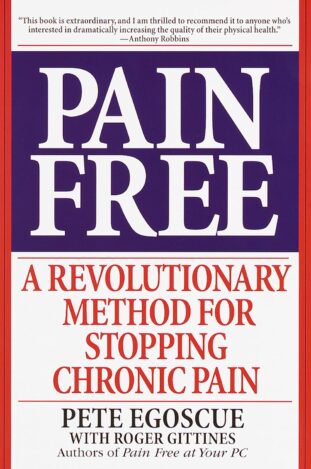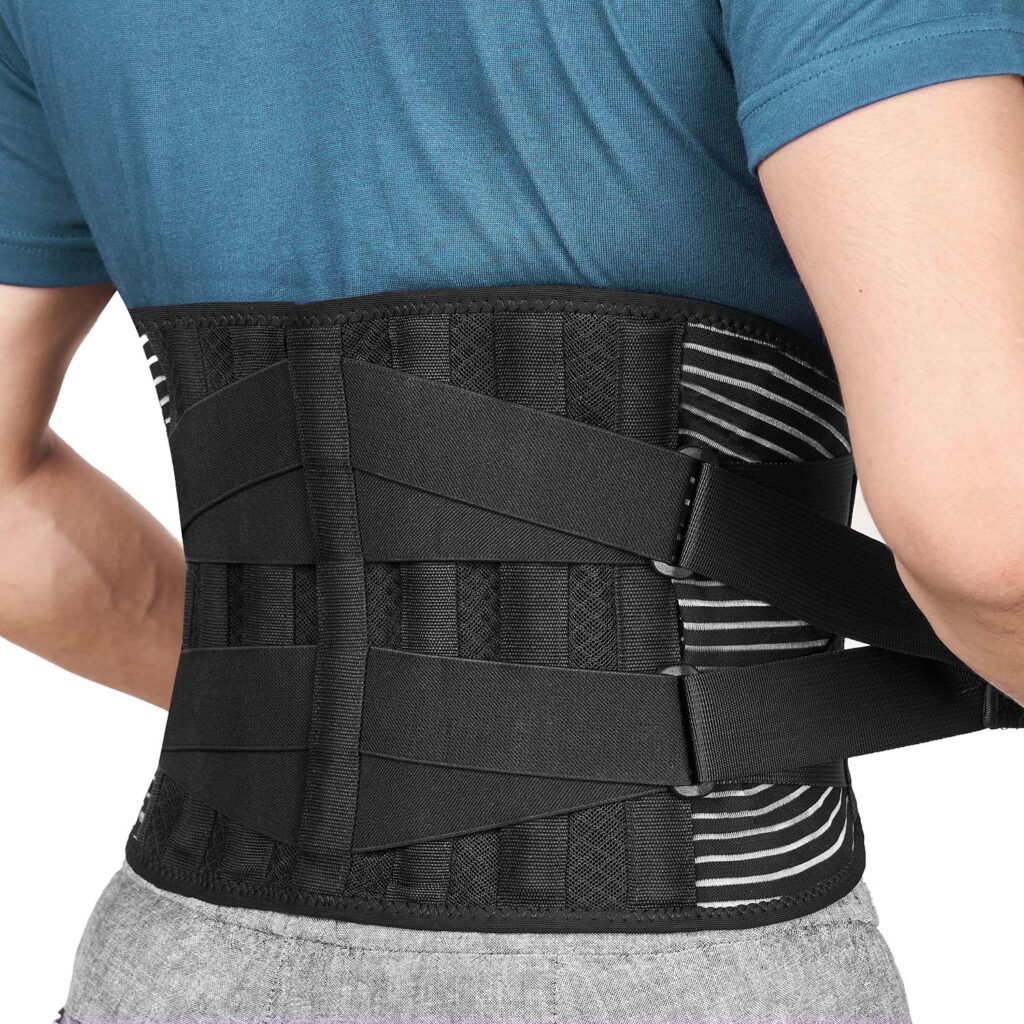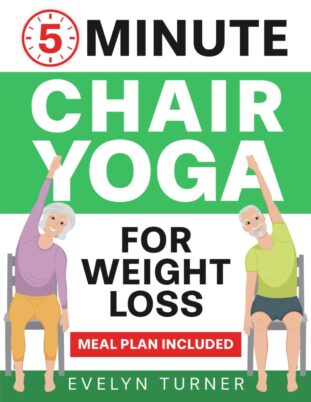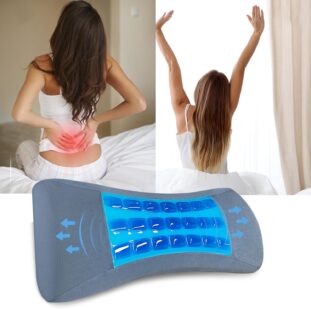Learn how to prevent chronic back pain which is defined as persistent discomfort or pain in the lower, middle, or upper back that lasts for 12 weeks or longer.
It can result from various factors, including poor posture, muscle strain, herniated discs, or underlying medical conditions.
This article reviews 12 practical ways to prevent chronic back pain grouped into 4 categories: posture related, regular exercise, a restful sleep environment and lifestyle habits.
Posture Related – How to Prevent Chronic Back Pain
1. Manage Your Weight & Prevent Chronic Back Pain
Maintain a healthy weight to reduce the load on your spine and decrease the risk of developing back pain.
Weight management plays a significant role in understanding how to prevent chronic back pain. Excess body weight places additional stress on the spine and its supporting structures, increasing the risk of developing back pain.
Maintaining a healthy weight through a balanced diet and regular exercise reduces the load on the spine, minimizing wear and tear on intervertebral discs. Weight loss can also alleviate pressure on nerves and improve overall mobility, contributing to a healthier back.
Adopting a lifestyle that prioritizes a well-balanced diet and regular physical activity not only supports weight management but also promotes optimal spinal health, reducing the likelihood of chronic back pain over time.
2. Maintain Good Posture
Practice proper posture while sitting, standing, and walking to reduce strain on your back muscles and spine.
Maintaining good posture is a central consideration when considering how to prevent chronic back pain. Proper alignment of the spine reduces stress on supporting structures and minimizes the risk of muscle strain.
Whether sitting at a desk, standing, or walking, it is essential to keep the spine in a neutral position, with shoulders relaxed and the natural curves of the spine maintained.
Regularly practicing back-friendly posture not only distributes weight evenly but also helps prevent undue pressure on spinal discs. If you find yourself sloughing over, use a back brace support.
In addition, incorporating ergonomic furniture and supportive chairs into daily activities reinforces the importance of maintaining good posture and contributes to overall spinal health in the quest to prevent chronic back pain.
3. Create Ergonomic Work Areas
Ensure that your work areas are ergonomically designed. These include the kitchen, bathroom or workspace. Creating an ergonomically friendly kitchen, bathroom or workspace involves optimizing the space to promote efficiency, comfort, and safety. Here are tips for each:
Kitchen
- Counter Heights: Ensure countertops are at a comfortable height to minimize bending or reaching. Customizing counter heights for specific tasks can reduce strain.
- Storage Accessibility: Place frequently used items in easily reachable cabinets or drawers. Consider pull-out shelves for lower cabinets to avoid excessive bending.
- Appliance Placement: Position frequently used appliances at counter height to reduce the need for heavy lifting or awkward bending.
- Proper Lighting: Install task lighting under cabinets to illuminate work areas and reduce eye strain.
- Non-Slip Mats: Place anti-fatigue or non-slip mats in front of the sink and stove to reduce the risk of slips and falls.
- Organized Layout: Arrange kitchen tools and utensils logically to minimize unnecessary movements. Keep commonly used items within arm’s reach.
Bathroom
- Grab Bars: Install grab bars in the shower/tub and near the toilet to provide support and prevent accidents.
- Accessible Storage: Use pull-out or roll-out shelves under the sink for easy access to toiletries and cleaning supplies.
- Non-Slip Flooring: Choose non-slip flooring to enhance safety, especially in areas prone to water exposure.
- Adjustable Showerheads: Install a showerhead with adjustable height to accommodate various user preferences and needs.
- Comfortable Height Fixtures: Set the height of bathroom fixtures, such as sinks and toilets, to accommodate users without unnecessary bending or stretching.
- Easy-to-Reach Towels: Place towel bars or hooks within easy reach from the shower or bathtub to avoid excessive stretching.
- Clear Pathways: Ensure clear pathways for easy maneuvering, especially for individuals using mobility aids.
Workspace
Ensuring an ergonomic workspace is an essential aspect of understanding how to prevent chronic back pain. Proper ergonomics in the home workplace involves optimizing the design of your workstation to support a neutral spine position.
- Chair and Desk Height: Adjust your chair and desk height to maintain a 90-degree angle at the hips, knees, and elbows.
- Lumber Support: Use a chair with lumbar support to reinforce the natural curve of the spine.
- Avoid Straining the Neck: Position your computer monitor at eye level to avoid straining the neck.
By creating a workspace that promotes good posture, you reduce the risk of musculoskeletal imbalances and chronic back pain. Regularly assessing and adjusting your ergonomic setup contributes to a more comfortable and spine-friendly work environment, fostering long-term back health.
4. Take Regular Breaks
Take breaks during prolonged periods of sitting or standing to stretch and move around, preventing stiffness and muscle tension. This is a practical approach in preventing chronic back pain.
Set a timer to remind yourself to stand up, stretch, and move around every 30 minutes. Gentle stretches during breaks help alleviate tension in the back muscles and maintain flexibility. These pauses not only prevent stiffness but also encourage better circulation, reducing the strain on the spine.
Incorporating regular breaks into your routine is a simple yet effective way to promote spinal health and mitigate the risk of developing chronic back pain associated with prolonged periods of static positioning.
5. Learn to Lift Objects Properly
Use proper lifting techniques, bending at the knees and keeping the object close to your body to avoid unnecessary strain on your back.
Learning how to lift objects with care is paramount in preventing chronic back pain. To safeguard your spine, bend at the knees rather than the waist when lifting. Keep the object close to your body, distributing the weight evenly.
Avoid twisting while lifting, as this can strain the back muscles and discs. Engage the core muscles to provide additional support to the spine during the lifting process.
By incorporating proper lifting techniques into daily activities, you reduce the risk of acute injuries and chronic strain on the back.
Regular Exercise
6. Have a Balanced Exercise Routine
Engage in a balanced exercise routine that includes strengthening exercises for the core muscles and flexibility exercises to improve spinal mobility.
Engaging in a regular exercise routine is a key strategy in understanding how to prevent chronic back pain. Exercise strengthens the core muscles, including the abdominals and lower back, providing essential support for the spine.
Activities such as walking, swimming, or yoga enhance flexibility and improve overall spinal health. Strong core muscles help stabilize the spine, reducing the risk of injuries and minimizing strain on the back.
Incorporating both aerobic exercises for cardiovascular health and targeted strength training for the core establishes a foundation for back pain prevention.
Also, maintaining a consistent exercise regimen promotes proper posture, flexibility, and overall well-being, contributing to a healthier spine and reducing the likelihood of developing chronic back pain.
7. Consult a Physical Therapist
A qualified physical therapist can provide personalized physical therapy exercises and stretches to strengthen the back muscles, enhance flexibility, and improve overall spinal health.
These exercises target specific areas of weakness or imbalance, addressing the root causes of potential back pain. A physical therapist can also educate on proper body mechanics and ergonomics to prevent injuries during daily activities.
Integrating physical therapy into a wellness routine establishes a proactive strategy for back health, making it an effective element in the comprehensive approach to how to prevent chronic back pain.
Regular sessions with a physical therapist can contribute to long-term spine resilience and well-being.
A Restful Sleep Environment
8. Use Proper Mattress and Pillows – How to Prevent Chronic Back Pain
Invest in a mattress and pillows that provide adequate support for your spine and promote a neutral sleeping position.
Selecting a proper mattress and pillows is essential in the quest to prevent chronic back pain. Your mattress should provide adequate support for the natural curves of the spine, maintaining a neutral sleeping position.
Select a medium-firm mattress to ensure a balance between comfort and support.
Pillows should support the head and neck without causing misalignment.
Replace your mattress and pillows regularly to maintain optimal support.
By creating a sleep environment that prioritizes spinal alignment and support, you contribute to overall back health, reducing the risk of waking up with stiffness or discomfort.
This investment in quality sleep essentials is a tangible and effective step in how to prevent chronic back pain.
Lifestyle Habits
9. Keep the Body Hydrated
Staying adequately hydrated is a valuable consideration in preventing chronic back pain. Drinking enough water helps maintain the elasticity of intervertebral discs, which act as shock absorbers in the spine.
Dehydration can lead to reduced disc height and increased susceptibility to herniation or injury. By drinking enough water, you support the natural functions of these discs, contributing to spinal health.
Proper hydration also facilitates nutrient transport to the spinal structures, promoting overall well-being. Making a habit of consuming an adequate amount of water each day is a simple yet effective measure in the broader strategy of how to prevent chronic back pain and maintain optimal spinal function.
10. Quit Smoking
Quitting smoking is an important step in preventing chronic back pain. Smoking has been linked to reduced blood flow and nutrient supply to spinal discs, leading to accelerated disc degeneration reducing the spine’s ability to absorb shock and increasing the risk of back pain.
The chemicals in cigarettes can also impair the healing process, increasing the vulnerability of the spine to injuries. By quitting smoking, you not only promote better circulation and nutrient delivery to the spine but also reduce the risk of developing conditions that contribute to chronic back pain.
Breaking the habit supports overall spinal health and enhances the body’s capacity to repair and maintain the integrity of the spinal structures, making it a significant aspect of strategies on how to prevent chronic back pain.
11. Manage Your Stress
Managing stress is a significant component of preventing chronic back pain. Chronic stress can contribute to muscle tension and exacerbate existing back issues.
Practice stress-reducing practices such as mindfulness, meditation, or yoga into your routine. These activities promote relaxation and alleviate tension in the muscles, reducing the likelihood of back pain.
In addition, maintaining a healthy work-life balance and implementing effective stress management strategies contribute to overall well-being.
12. Wear Correct Footwear
Choose comfortable and supportive footwear to maintain proper body alignment and reduce strain on your back.
Footwear is a practical consideration in preventing chronic back pain. Choosing comfortable and supportive shoes helps maintain proper body alignment and reduces strain on the back.
- Foot Pain in Seniors – Can Be Agonizing
- Shoes for Arthritis – Compare Stylish Options
- Best Shoes for Seniors – Wonder How to Select
- Shoes for Diabetics – How to Choose
- Velcro Shoes for Seniors – Do not Need to be Ugly
Select shoes with cushioning and arch support to absorb shock during walking or standing. Avoid high heels, cheap shoes or shoes with inadequate support, as they can contribute to poor posture and increase the risk of back pain.
Regularly assess your footwear and replace worn-out shoes to ensure continued support. An investment in comfortable and supportive shoes for your daily activities contributes to a stable foundation, promoting overall spinal health and minimizes the risk of developing chronic back pain.
Conclusion – How to Prevent Chronic Back Pain
To prevent chronic back pain, adopt a multifaceted approach. Prioritize good posture, ensuring proper alignment during daily activities. Regular exercise, encompassing both strength training and flexibility exercises, strengthens core muscles and supports spinal health.
Maintain a healthy weight to reduce stress on the spine, and invest in an ergonomic workspace to promote optimal posture. Lift objects with care, keeping them close and bending at the knees.
Stay hydrated for intervertebral disc health and quit smoking to prevent accelerated degeneration. Choose supportive footwear and a suitable mattress to reinforce spinal alignment.
Manage stress through practices like mindfulness, and consider physical therapy for personalized exercises.
Related Articles
- Why Is Water Important to Your Health? – Facts To Know
- Poor Balance in Seniors – Why Oh Why?
- Improve Posture in Seniors – A Simple Mobility Trick
- Top Rated Orthopedic Pillows for Neck Pain – The Best Options
- Special Pillows for Neck Pain – Not Orthopedic
- 5 Best Recliners for Back Pain – What to Look For
FAQ – Prevent Chronic Back Pain
What lifestyle changes can I make to prevent chronic back pain?
Regular exercise, maintain a healthy weight, practice good posture, and avoid prolonged sitting or standing can all prevent chronic back pain.
Are there any specific exercises to prevent back pain?
Exercises that strengthen core muscles, such as planks, bridges, and pelvic tilts, can help prevent back pain by providing stability and support to the spine.
What ergonomic adjustments should I make to prevent back pain?
Adjust your workspace ergonomics, use supportive chairs with proper lumbar support, ensure the computer monitor is at eye level, and take regular breaks to stretch can help you prevent back pain associated with prolonged sitting.
References
John Hopkins Medicine (2023) 7 Ways to Treat Chronic Back Pain Without Surgery https://www.hopkinsmedicine.org/health/conditions-and-diseases/back-pain/7-ways-to-treat-chronic-back-pain-without-surgery







Great information. Thanks for sharing these.
Thanks for the read! Delighted that you found value in the article